“I try to make good tasting wine that will age well.”

“I try to make good tasting wine that will age well. While everyone else seems to believe in doing minimal manipulation with the goal of letting the vineyard site speak, I find that since grapes do not walk off the vines and into the winery, let alone into barrels and bottles, we must actually do something with the grapes and wine along the way from time to time. Rest assured that I do try to get in the way as little as possible while trying to achieve the desired outcome. Most of our work is done and choices are made during the harvest season. Afterward, there is little reason to touch a wine that is on a wonderful trajectory. With the exception of our Dry Rosé, all our wines are bottled without fining or filtration.
Sometimes we bottle wines from single vineyards, or even blocks within a vineyard. Usually, these vineyard designates are the synthesis of multiple sub-sites within a given vineyard. Sometimes we bottle ‘Appellation wines’ that are also single vineyard sourced but happen not to have unusually specific geographic personality beyond being delicious examples of their appellation. These Appellation wines are the result of blending carefully selected vineyard sites to achieve balance and harmony. Occasionally, such as with our Zinfandoodle, we blend between two vintages to achieve this balance and harmony. If any parcels are left over that are not assets to these wines, they find a home in someone else’s program, rather than ours.”
Fred regularly underplays the wines’ provenance rather than overplays it. This causes some confusion and frustrates merchants who sell our wines. For this, he offers his apologies. “I am, however, unlikely to change this deeply ingrained habit” he adds emphatically. Below are Fred’s explanation of each wine’s essential method:
Chardonnays are barrel fermented (some new, some old), full malolactic, and bottled without fining or filtration after nearly 2 years s in barrel. I used to employ UCD 522 (aka Montrachet) yeast to conduct the lion’s share of fermentation. I liked the fact that it can go bone dry as well as the characteristics it imparts while on lees despite its well-known idiosyncrasies. Beginning in 2009/2010, I phased in the practice of allowing indigenous yeasts to conduct the entire fermentation. This seems to allow the resulting wine to express its site more clearly while also getting into it’s great drinking zone a couple of years sooner. I tend to use a little more SO2 at bottling for Chardonnay than most California producers do even though the wines are bone dry. My feeling is that since they do not have the tannin of red wines, they need oxidative protection at bottling in order to age into something more than simply tired white wine. I value mouth-watering acidity while respecting the relative generosity of a given site. Our almost 30 year run with this variety proves the value of this.
See our Chardonnay offerings
These vinifications are quite similar: simple and rather traditional. Sorted, destemmed, uncrushed fruit is gently dropped into open-top fermentation tanks and chilled to about 15–16° C if needed in order to delay fermentation so I can focus on the harvest date selection of following parcels. Once indigenous yeasts are active, I often augment with a yeast strain/culture that I believe flatters the site’s usual personality. Numerous trials have shown that the often the dominant Saccharomyces in uninoculated and inoculated fermentations ends up being a strain already resident within the winery. I think that ‘natural’ microflora expression has as much to do with early acting non-Saccharomyces species that arrive with the grapes than the final alcohol-tolerant organisms, inoculated or resident.
Human manual punchdowns force better knowledge of the material during fermentation and grinds the grapes up less than mechanized devices. I prefer mixing and gently crushing the grapes over many days to the even more reserved approach of pumping the fermenting liquid over the solid parts. Usually some days after going dry, based on taste alone, the vats are drained and pressed (end point dictated by taste) to another tank so that the heaviest kinds of solids may settle out and not contribute their often undesirable characters to the wine in the years that follow. Usually barreled the following day, the Zinfandel, Pinot Noirs and Grenache rest on their lees two to three winters until bottling as of the 2013 vintage. Because size really does matter, the Grenache is placed into larger format barrels than the Pinot Noir. Zinfandel enjoys both sizes.
See our Pinot Noir, Grenache and Zinfandel offerings
The Cabernet Sauvignon and Syrah are vinified with destemmed (but uncrushed) fruit in open-top vats – with manual human punchdown during fermentation and extended time on skins before pressing. In the past they were allowed to age on initial lees, generally for 6 to 9 months before first racking until the 2012/2013 vintage when this racking was eliminated. This necessitates even more extra time in barrel to fully develop before bottling. This takes nearly three to years, and sometimes longer. I have found this to preserve certain nuances in the fruit as well as texture over the long run, which is really the prize. This is important to me, especially as these are 100% varietal wines. Fortunately, there is enough soil and rootstock variation within the Scherrer Cabernet vineyard, I am able to blend the different components for complexity and balance each vintage. Cabernet Sauvignon typically has a fond appetite for new French Oak which I choose to feed appropriately. The Syrah, on the other hand, does not need or want new oak as it is a complete package as it arrives from the vineyard. It also has the benefit of being composed of many clones for the Calypso bottling as well as different sites in the case of Appellation bottlings and they gain further complexity and interest from the grape alone. The Syrah/Grenache blends receive similar treatment except generally in larger format cooperage.
See our Cabernet Sauvignon and Syrah offerings
Red wines are bottled without fining or filtration with judiciously appropriate SO2. My goal is to allow at least one year in bottle before release to the trade. Often, my mailing list is offered wines earlier, but they are usually planning to age them themselves.
Dry Rosé used to come from juice bled from some red tanks in 1997-2010. Beginning in 2010 I have experimented with whole–cluster pressing of red grapes as well. Since 2011, the latter technique has been used exclusively, needing really only Syrah, Zinfandel and Grenache to be a complete package. The juice is fermented in old barrels and generally bottled without filtration. It is bone dry with very bright acidity and is intended to age for several years.
See our Dry Rose offerings

